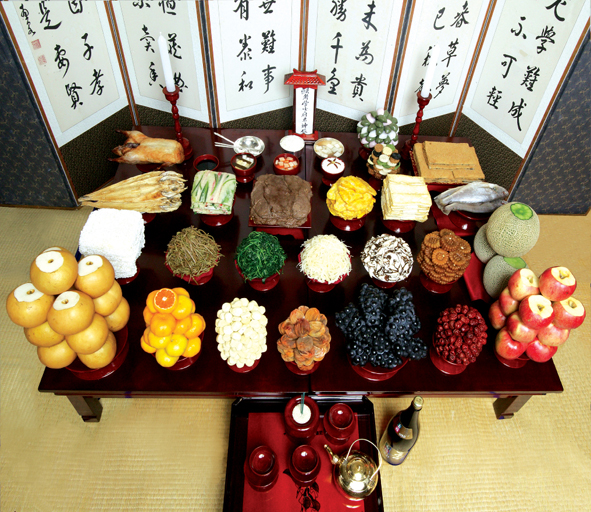[Jan] Ask Us about Korea: Charye table
Date Jan 24, 2022
 A photo of the ritual table for Charye / Courtesy of Imperial Palace Boutique Hotel
A photo of the ritual table for Charye / Courtesy of Imperial Palace Boutique Hotel
Q. What goes on the ritual 'Charye' table?
A. The ritual table set up to honor ancestors during Charye ceremonies for Seollal or Chuseok takes a long time to prepare, and the dishes are placed according to certain rules. The types of dishes and order of placement can vary depending on the region and a family’s traditional preference. But most often, the ritual table consists of five rows of dishes.
A folding screen is placed just behind the table and should be facing south, so the people taking part in the Charye can face North during the ceremony. The names of deceased relatives are written on Hanji, Korean traditional paper, and placed on the table just in front of the screen to represent those ancestors’ spirits.
Staples like rice, soup and rice cakes along with utensils and liquor glasses are placed in the first row, closest to the screen. Whereas Koreans universally eat with their rice bowls to the left of their soup bowls, on Charye tables, the rice is placed to the right of the soup – the proper order for those residing in the spirit world.
The second row usually has main dishes like yukjeon (beef pancakes), sanjeok (seasoned beef on skewers) and grilled fish. The heads of the fish should be facing east (that is to the right). The third row typically has three different soups: one beef-, seafood- and tofu-based.
The fourth row has dried fish on the left end and sikhye (a sweetened rice beverage) at the opposite end. Stir-fried vegetables and other side dishes are placed in between.
The last row is for desserts like fruit, nuts and traditional sweet snacks: Dates, chestnuts, Korean pears and persimmons are placed in that order from the left. Yakgwa (deep-fried, wheat-based cookies) and hangwa (molded dough-based or airy-fermented rice cookies) are placed on the right side.
Peaches and red beans are never offered during these ceremonies as they are believed to scare away ghosts.
**“Ask Us about Korea” is a Q&A section about Korea and Korean culture. If you have any relevant questions, please send us an email (KOCIS@korea.kr). We’ll choose one of the questions sent by our readers and answer it in this section.**

The Ministry of Culture, Sports and Tourism's "Korea Here & Now" work can be used under the condition of "Public Nuri Type 1 (Source Indication)."




